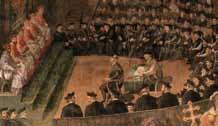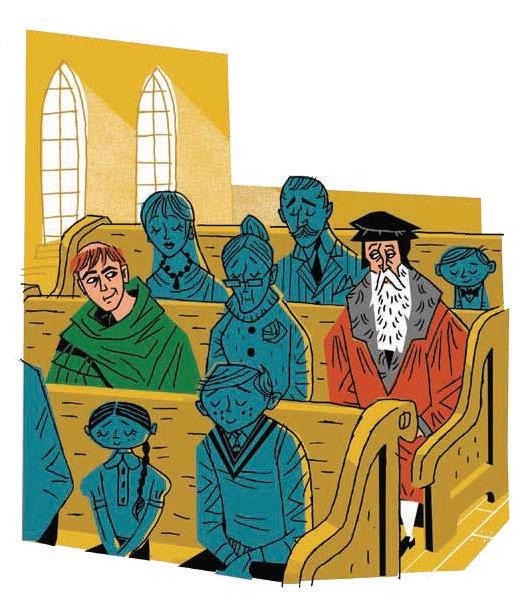
15 minute read
The Inventions of Rome
by W. ROBERT GODFREY
For vast numbers of people, Roman Catholicism is the religion of choice. Rome can be attractive for a wide variety of reasons. The most significant is familial, people born into and persevering in the Roman Church. But other attractions of various sorts can be readily found: theological, philosophical, liturgimany more doctrines, cutting itself off from its mecal, moral, psychological, and historical. dieval form by condemning views it had then toleratfourth or fifth iteration of that organization, each in ancient form, the medieval form, the Tridentine form (formed at the time of the Council of Trent, er Christian churches insisting on absolute Roman ed. In its post-Tridentine Defenders of Protestantism over the centuries have holds the decisions of Trent, but in practice moves entered the lists, confronting at great length all of beyond and contrary to Trent. As the Tridentine Rome’s attractions. Understandably, the discuschurch claimed to supplement the Bible with tradisions have often focused particularly on biblical and tion, but in fact used its traditions to contradict the theological arguments. But historical arguments are Bible, so the post-Tridentine church has claimed to of great importance as well. Rome often claims that supplement Trent with other teachings, but in fact it represents two thousand years of unbroken aphas used those other teachings to contradict Trent. ostolic succession and practice. The implication The extensive claims of the previous paragraph is that no fundamental changes have taken place cannot be elaborated or substantiated in the space in the church, but only a legitimate development of this article. My purpose is simply to present some of principles found at the beginning. I believe that of the statements of the sixteenth-century Council this historical claim is profoundly false, and that in of Trent and the nineteenth-century First Vatican the interests of truth and biblical religion it must Council in which historical claims for the Roman be challenged. church are made, and then evaluate those claims in
The Roman Catholic Church today is at least the light of history. basic ways different from the others. There is the SCRIPTURE AND TRADITION 1545–1563), and then at least two post-Tridentine In the sixteenth century, the Reformers taught that forms shaped by two very dierent councils: Vatithe Bible alone was the church’s ultimate authorican I (1868–1870) and Vatican II (1962–1965). In ty, while the Roman Catholics responded that traits ancient form, Rome was in fellowship with the dition along with Scripture were the authority for other Christian churches and held to Nicene orthothe church. The Council of Trent defined this Rodoxy. In its medieval form, it separated from othman position in these terms: forms, it theoretically upsupremacy, defining certain doctrines such as tranSeeing clearly that this truth and discipline substantiation, but leaving many other doctrines are contained in the written books, and the (such as justification and the authority of tradition) unwritten traditions which, received by the open to discussion. In its Tridentine form, it defined Apostles from the mouth of Christ himself, or
from the Apostles themselves, the Holy Ghost dictating, have come down even unto us, transmitted as it were from hand to hand. 1
This position continued to characterize the Tridentine church as it was reiterated in almost identical language by the First Vatican Council (1870). 2 In the decrees of these two councils, we read nothing of evolving or developing traditions. Instead, the historical claim made by each is crystal clear: the authoritative traditions of the Roman Church were taught by the apostles in the first century. Such a claim is entirely untenable, as any informed Roman Catholic must acknowledge today. And so many Roman apologists now seek to show how current Roman teachings and practices, supposedly based on tradition, have progressed and grown from a kernel of truth found in the time of the apostles, and thereby justify contemporary practice. The problem with such an apologetic is that it contradicts what Trent and the First Vatican Council declared.
John Calvin, in one of the most trenchant early criticisms of Trent, remarkably turned the table on Rome saying, in eect, that he would accept the authority of apostolic tradition as defined by Trent if the Romanists could oer historical proof for their claims of tradition. Calvin recognized already in the sixteenth century that such proof could not be presented. 3 Historical studies since then have made Trent’s claims even more impossible to demonstrate.
As we examine the decisions of Trent carefully, we find various places in which it claims the authority of tradition as the foundation of its teaching, particularly with respect to the sacrament of the Lord’s Supper.
TRANSU BSTANTIATION Trent teaches that its doctrine of transubstantiation is not only a perpetual, but also a sincere and firm commitment of the church even in ancient times:
And because that Christ, our Redeemer, declared that which he oered under the species of bread to be truly his own body, therefore, has it ever been a firm belief in the Church of God, and this holy Synod doth now declare it anew, that, by the consecration of the bread and of the wine, a conversion is made of the whole substance of the bread into the substance of the body of Christ our Lord, and of the whole substance of the wine into the substance of his blood. 4
ADORATION OF THE H O S T Trent also teaches that worshipping the consecrated bread and wine of the Lord’s Supper is an apostolic tradition going back to the earliest days of the church:
Wherefore, there is no room left for doubt, that all the faithful of Christ may, according to the custom ever received in the Catholic Church, render in veneration the worship of latria, which is due to the true God, to this most holy sacrament. 5
SACRIFICE OF THE MASS Remarkably, Trent also declares both that the Mass was an unbloody, propitiatory sacrifice for the sins of the living and the dead, and that this was the consensus of the apostolic tradition:
And forasmuch as, in this divine sacrifice which is celebrated in the mass, that same Christ is contained and immolated in an unbloody manner who once offered himself in a bloody manner on the altar of the cross; the holy Synod teaches, that this sacrifice is truly propitiatory….Wherefore, not only for the sins, punishments, satisfactions, and other necessities of the faithful who are living, but also for those who are departed in Christ, and who are not as yet fully purified, is it rightly oered, agreeably to a tradition of the apostles. 6
Suffice it to say, no reputable church historian would confirm any of these historical claims of the Council of Trent. Even if some very ancient support for some of these teachings were found, it would not substantiate Trent’s claims of clear and broad acceptance of them in the early period of the ancient church.
SCRIPTURE AND ITS INTERPRETATION
In addition to its decisions on tradition, Trent further decreed that only the church could properly interpret the meaning of the Bible, and further claimed that this position was the unanimous teaching of the church fathers:
Furthermore, in order to restrain petulant spirits, it decrees, that no one, relying on his own skill, shall, in matters of faith, and of morals pertaining to the edification of Christian doctrine,—wresting the sacred Scripture to his own senses, presume to interpret the said sacred Scripture contrary to that sense which holy mother Church,—whose it is to judge of the true sense and interpretation of the holy Scriptures,—hath held and doth hold; or even contrary to the unanimous consent of the Fathers. 7
The position articulated by Trent against sola scriptura has rightly sometimes been called sola ecclesia (by the church alone). It is not so much the Bible and tradition that determine the truth as the decisions of the church as to the meaning of the Bible and tradition. Here too, however, Rome’s claim is not that its teachings have evolved, but that it teaches what the whole church and the fathers of the church have always taught. Calvin saw that in fact Rome did not give any real authority to the Bible. Rather, Rome made the Bible into a wax nose that would be reshaped to mean whatever Rome wanted it to mean. 8
Calvin indeed recognized an important role for the church in interpreting the Bible, but has a very different notion of what the church is. For Rome, the church is the authoritative hierarchy that by its power decides the meaning of the Bible. For Calvin, the interpretation of the Bible in di±cult matters should be given to learned members of the church to study the meaning of the Bible humbly and submissively. 9
The question remains, of course, as to who exactly determines the meaning of the Bible and tradition for the Roman Catholic Church. Some in the sixteenth century looked to the great theological faculties in the universities. Many believed that only thepope and ecumenical councils could speak for the whole church. That is the view enshrined in the Tridentine Profession of Faith of 1564, issued by Pope Pius IV after the Council of Trent had adjourned and made binding on all who taught in the Roman Church. 10 This profession declared the necessity of following the pope and the ecumenical councils:
X. I acknowledge the holy Catholic Apostolic Roman Church for the mother and mistress of all churches; and I promise and swear true obedience to the Bishop of Rome, successor of St. Peter, Prince of the Apostles, and Vicar of Jesus Christ.
XI. I likewise undoubtingly receive and profess all other things delivered, defined, and declared by the Sacred Canons and General Councils, and particularly by the holy Council of Trent. 11
The point to take note of here is that the Tridentine Profession of Faith assumes the authority of the ecumenical councils as well as popes, and further, assumes the agreement of popes and councils. In fact, the historical reality is quite the contrary to Rome’s claims, for the pope historically rejected what ecumenical councils said about Rome. Consider the famous sixth canon of the Council of Nicaea (325):
The ancient custom, which has obtained in Egypt, Libya, and the Pentapolis, shall continue in force, viz.: that the bishop of Alexandria have rule over all these [provinces], since this also is customary with the bishop of Rome. Likewise also at Antioch and in the other eparchies, the churches shall retain their prerogatives. 12
Clearly the Council of Nicaea knew nothing of the notion that the bishop of Rome ruled over all the churches. Obstinately, Rome has not submitted to this canon of an ecumenical council, thus challenging the notion of pope-and-council harmony.
A second and more surprising example can be taken from the second ecumenical council of Constantinople (381). At that time, the bishop of Constantinople was declared to have “the precedence in honor, next to the bishop of Rome.” 13 The meaning of this statement is explained more fully in the twenty-eighth canon of the fourth ecumenical council, the Council of Chalcedon (451). After expressing its agreement with the Council of Constantinople on the bishop of Constantinople, the canon continued:
For with reason did the fathers confer prerogatives…on the throne [the episcopal chair] of ancient Rome, on account of her character as the imperial city…; and, moved by the same consideration, the hundred and fifty bishops [at the Council of Constantinople] recognized the same prerogatives…also in the most holy throne of New Rome [Constantinople]; and with good reason judging, that the city, which is honored with the imperial dignity and the senate [i.e., where the emperor and senate reside], and enjoys the same [municipal] privileges as the ancient imperial Rome, should also be equally elevated in ecclesiastical respects, and be the second after her. 14
The papal legates at the council protested this canon, but the council passed it anyway. Clearly the great ecumenical council did not acknowledge the right of the pope to determine its actions. Important to note is that for the council the discussion of the honor accorded to the bishop of Rome was purely a matter of its relation to the imperial system. 40
AND FURTHERMORE…
Other untenable historical claims made by the Council of Trent include:
Trent declared the antiquity of the doctrine of Purgatory. 1
Trent grounded the veneration of images in apostolic practice. 2
Tre n t i n s i s te d o n t h e a n t i q u i t y o f indulgences. 3
Vatican I, then, reinforces these claims for the antiquity of the pope’s teaching on such matters:
For the Pope that “the Holy Spirit was not promised to the successors of Peter, that by his revelation they might make known new doctrine; but that by his assistance they might inviolably keep and faithfully expound the revelation or deposit of faith delivered through the Apostles. And, indeed, all the venerable Fathers have embraced, and the holy orthodox doctors have venerated and followed, their Apostolic doctrine; knowing most fully that this See of holy Peter remains ever free from all blemish of error according to the divine promise of the Lord our Saviour made to the Prince of his disciples: ‘I have prayed for thee that thy faith fail not, and, when thou are converted, confirm thy brethren.’” 4
1 PHILIP SCHAFF, CREEDS OF CHRISTENDOM (GRAND RAPIDS:
BAKER BOOKS, 1998), 2:198. 2 SCHAFF, CREEDS, 2:200. 3 SCHAFF, CREEDS, 2:205. 4 SCHAFF, CREEDS, 2:268FF AND CITING LUKE 22:32.

No mention is made of Christ or Peter in this matter. This canon is also rejected by Rome, again challenging the notion that popes and councils have always agreed.
VATICAN I AND PAPAL I N FALLIBILITY
In many ways, the logical culmination of Rome’s claims for itself was the declaration of the First Vatican Council (1870) regarding the authority and infallibility of the pope. This council reiterated that what it taught about the pope was “in accordance with the ancient and constant faith of the universal Church.” 15 Further, it insisted that the doctrine of papal authority over the whole church is necessary for salvation: “Hence we teach and declare that by the appointment of the Lord the Roman Church possesses a superiority of ordinary power over all other churches….This is the teaching of the Catholic faith, from which no one can deviate without loss of faith and salvation.” 16
The irony and historical inaccuracy of this statement is outrageous. To abide by this teaching, the Eastern churches and many Western churches of the ancient period are read out of the true church without a moment’s hesitation. The absolute authority of the bishop of Rome is not only ancient and universal, one most held to be Roman Catholic, but it is also necessary for salvation for everyone.
The council goes beyond asserting the authority of the pope over all churches. It also declares that he is infallible in his o±cial teaching. The more familiar section of the declaration is as follows: “Adhering to the tradition received from the beginning of the Christian faith…we teach and define…that the Roman Ponti, when he speaks ex cathedra…is possessed of that infallibility.” 17 In context, the assertion about the pope is actually even stronger: “This See of holy Peter remains ever free from all blemish of error.” 18 Has anyone ever believed that?
The pope who called and directed the First Vatican Council was Pius IX. In perfect harmony with the sentiments of the statements, when it was suggested to him that he at least seek the advice of bishops and the tradition of the church in matters of doctrine, Pius IX answered, “Tradition, I am tradition.” 19 For the Tridentine Roman Church, its authority truly is sola papa (by the pope alone). The arrogance of Pius IX and his council is truly staggering. Few Roman Catholic scholars in the postTridentine church accept these sweeping claims as being either historical or binding.
THE ONGOING NEED FOR R E FO RMATION
Since Calvin’s time, Rome has continued its defense of itself through complicated arguments full of distinctions made after the fact. I have quoted at length from two of Rome’s own ecumenical councils to show how great is the distance between what the documents say and how Rome treats them. Rome’s historical arguments are simply not credible, though most Roman Catholics either do not know them or do not think about them. Those that do know them in the end follow the founder of the Jesuits, Ignatius Loyola, who wrote: “If we wish to proceed securely in all things, we must hold fast to the following principle: What seems to me white, I will believe black if the hierarchical Church so defines.” 20 Such a position is not worthy of a Christian or of biblical religion. 21
W. Robert Godfrey is professor of church history and president of Westminster Seminary California (Escondido, California).
1 Philip Scha, Creeds of Christendom (Grand Rapids: Baker Books, 1998), 2:80. 2 Scha, Creeds, 2:241. 3 John Calvin, “Canons and Decrees of the Council of Trent, with the Antidote,” Selected Works (Grand Rapids: Baker Books, 1983), 3:69. 4 Scha, Creeds, 2:130. 5 Scha, Creeds, 2:131. 6 Scha, Creeds, 2:179. 7 Scha, Creeds, 2:83. 8 Calvin, 69. 9 Calvin, 74. 10 Scha, Creeds, 1:97. 11 Scha, Creeds, 2:209. 12 Philip Scha, History of the Christian Church (Grand Rapids: Eerdmans, 1910), 3:275. 13 Scha, History, 3:277. 14 Scha, History, 3:279. 15 Scha, Creeds, 2:258. 16 Scha, Creeds, 2:262. 17 Scha, Creeds, 2:270. 18 Scha, Creeds, 2:269. 19 Cited in Robert Strimple, “The Relationship between Scripture and Tradition in Contemporary Roman Catholic Theology,” Westminster Theological Journal 40 (Fall 1977), 29. 20Cited in Lewis W. Spitz, The Protestant Reformation, 1517–1559 (New York:
Harper and Row, 1985), 306. 21 For additional information on the claims of this article, see the faculty blog of Westminster Seminary California: www.wscal.edu/blog.





